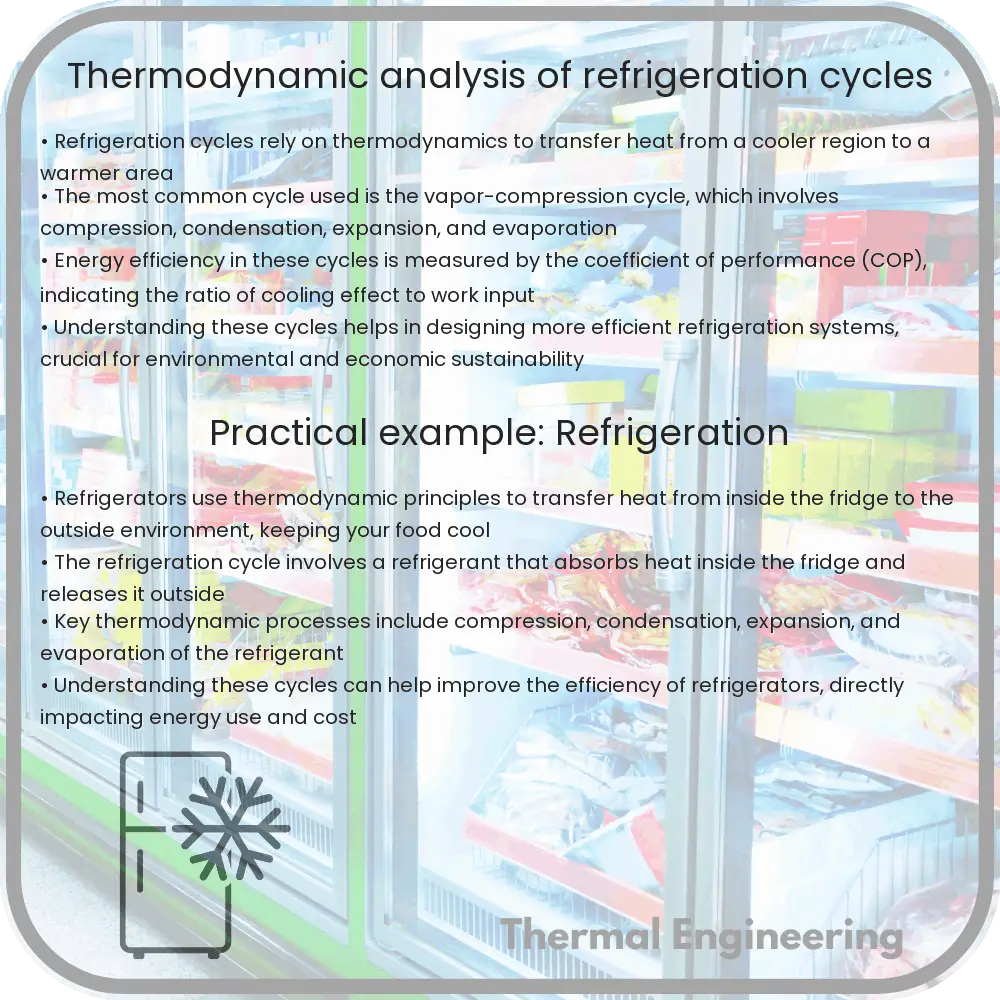Learn about thermodynamic analysis in optimizing refrigeration cycles, from basic components to efficiency metrics.

Understanding Thermodynamic Analysis of Refrigeration Cycles
Refrigeration cycles are pivotal in many engineering applications, from air conditioning systems to industrial refrigeration. The primary goal of these cycles is to remove heat from a low-temperature region and expel it to a high-temperature region. To understand how these cycles operate and can be optimized, a thermodynamic analysis is essential.
Basics of the Refrigeration Cycle
The most common type of refrigeration cycle is the vapor-compression cycle, which consists of four main components: the evaporator, the compressor, the condenser, and the expansion device. The cycle operates by compressing a refrigerant, then condensing it, expanding it, and finally evaporating it. These cycles are usually represented on a pressure-enthalpy (P-h) diagram.
- Evaporator: Absorbs heat from the environment, causing the refrigerant to evaporate.
- Compressor: Increases the pressure of the refrigerant vapor, thereby raising its temperature.
- Condenser: Releases the absorbed heat to the outside environment, leading to condensation of the refrigerant.
- Expansion Device: Reduces the pressure of the refrigerant, which partially vaporizes and cools down significantly.
Thermodynamic Principles Involved
Thermodynamic analysis of refrigeration cycles primarily involves the principles of energy conservation and entropy balance. The First Law of Thermodynamics, which states that energy cannot be created or destroyed, is used to evaluate the energy transfers in the form of heat and work. The Second Law of Thermodynamics, which involves entropy, helps in assessing the irreversibility of the processes within the cycle.
Energy Analysis of a Refrigeration Cycle
Energy balance can be applied to each component of the cycle, where the change in internal energy of the refrigerant equals the heat transferred plus the work done. Mathematically, this can be expressed for each component:
- In the compressor, the work input, \( W_{in} \), can be calculated using the equation:
\[
W_{in} = \dot{m} \cdot (h_2 – h_1)
\] where \( \dot{m} \) is the mass flow rate of the refrigerant, and \( h_2 \) and \( h_1 \) are the enthalpies of the refrigerant at the compressor outlet and inlet, respectively. - The condenser releases heat, \( Q_{out} \), given by:
\[
Q_{out} = \dot{m} \cdot (h_2 – h_3)
\] with \( h_3 \) as the enthalpy post-condensation. - In the evaporator, the heat absorbed, \( Q_{in} \), is:
\[
Q_{in} = \dot{m} \cdot (h_1 – h_4)
\] where \( h_4 \) is the enthalpy pre-evaporation.
Efficiency and Performance
The efficiency of refrigeration cycles can be measured using the coefficient of performance (COP), which is a ratio of the amount of heat removed from the refrigerated space to the work input required to remove the heat. It is expressed as:
\[
COP = \frac{Q_{in}}{W_{in}} = \frac{\dot{m} \cdot (h_1 – h_4)}{\dot{m} \cdot (h_2 – h_1)}
\]
Improving the COP involves optimizing each component of the cycle to reduce losses, enhance heat transfer, and minimize irreversibility.
Conclusion
Thermodynamic analysis of refrigeration cycles provides crucial insights into the operation and efficiency of refrigeration systems. By applying the principles of thermodynamics, engineers can design more efficient systems that use less energy and have a reduced environmental impact.
Understanding these principles is not just academic; it has practical, everyday applications in designing systems that keep our food fresh, our rooms cool, and our industries running efficiently.